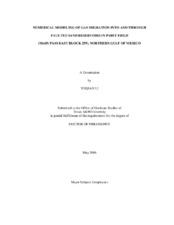| dc.description.abstract | The further exploration and development of Pabst Gas Field with faulted sand reservoirs require an understanding of the properties and roles of faults, particularly Low Throw near Vertical Faults (LTNVFs), in gas migration and accumulation at a reservoir scale. This study presents numerical modeling of gas migration and accumulation processes in Pabst Field. Based on studies of the reservoirs, structure, faults, and fluid properties of the field, reservoir scale modeling was performed to determine the gas supply style and the fault properties by means of hundreds of iterations in which the fault properties and gas supply pattern were modified to match the gas distribution obtained from modeling with the gas distribution inferred from seismic data constrained by well data and production data. This study finds that in the main three sand reservoirs of Pabst Field the overlying younger sands cut down into the underlying older sands, so that partial connections between the three sands allow gas communication among the sands. Meanwhile, three fault families break up the three sands into numerous compartments. A primary fault and large synthetic and antithetic faults act as gas migration pathways: the synthetic and antithetic faults are inlets for gas flow and the primary fault is an outlet, and LTNVFs act as barriers to gas flow. Modeling requires fault properties in the field to change while the field is formed. The porosity and permeability of the faults in Pabst Field are 10% and 0.1 md, respectively, during gas charging of the sand reservoirs. But when there is no gas charging and large gas columns are maintained, the porosity and permeability of the faults decrease to 6% and 0.001 md, respectively. Pabst Field probably has an impulse gas charge history. Fault opening and closing, gas charge and recharge, and replacement of gas by formation water may occur. A combination of stratigraphy, structure, overpressure and gas charge rate control gas migration style, gas charge history, and gas distribution in the field. The significance of the study is that this improved numerical approach for modeling gas migration into and through specifically faulted sand reservoirs fills the gap between basin modeling and production modeling. | en |


